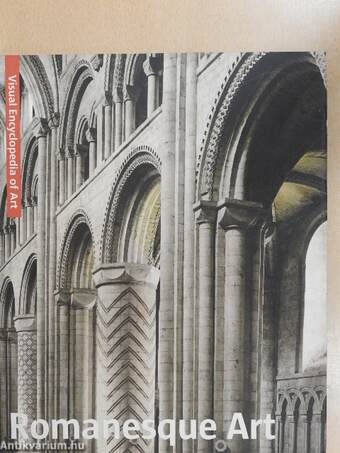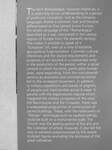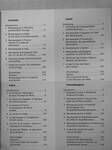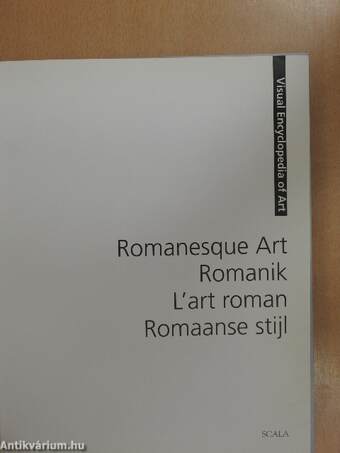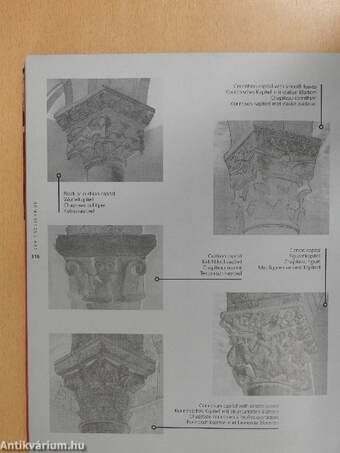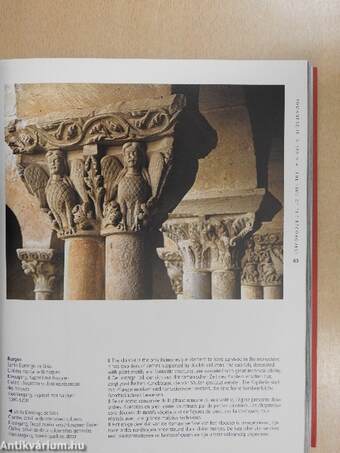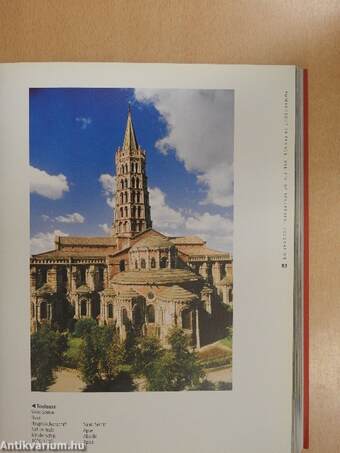1.068.249
kiadvánnyal nyújtjuk Magyarország legnagyobb antikvár könyv-kínálatát

VISSZA
A TETEJÉRE
JAVASLATOKÉszre-
vételek
Romanesque Art/Romanik/L'art roman/Romaanse stijl
| Kiadó: | Scala Group S.p.A. |
|---|---|
| Kiadás helye: | Firenze |
| Kiadás éve: | |
| Kötés típusa: | Fűzött papírkötés |
| Oldalszám: | 319 oldal |
| Sorozatcím: | Visual Encyclopedia of Art |
| Kötetszám: | |
| Nyelv: | Angol Francia Német Holland |
| Méret: | 24 cm x 20 cm |
| ISBN: | 978-888117805-6 |
| Megjegyzés: | Színes fotókkal és reprodukciókkal gazdagon illusztrálva. |
naponta értesítjük a beérkező friss
kiadványokról
naponta értesítjük a beérkező friss
kiadványokról
Előszó
TovábbFülszöveg
The term Romanesque, however imprecise, is a useful key to our understanding of a period of profound innovation. Just as the romance languages shared a common root and became differentiated as they spread across Europe, the artistic language of the "Romanesque" diversified as it was interpreted in the various regions of Europe from the eleventh century. This makes it possible to speak of a "European"art, even at a time of extreme geo-political fragmentation. Common cultural references and the shared requirements and purposes of art resulted in a substantial unity in the production of the period, within a social context in which horizons, particularly human ones, were expanding. From the mid-eleventh century an economic and commercial revival led to the increased movement, in addition to military expeditions and bands of pilgrims, of people and merchandise across Europe. In parallel with the expansionist impulse which triggered the military conquests of the west, the Reconquista... Tovább
Fülszöveg
The term Romanesque, however imprecise, is a useful key to our understanding of a period of profound innovation. Just as the romance languages shared a common root and became differentiated as they spread across Europe, the artistic language of the "Romanesque" diversified as it was interpreted in the various regions of Europe from the eleventh century. This makes it possible to speak of a "European"art, even at a time of extreme geo-political fragmentation. Common cultural references and the shared requirements and purposes of art resulted in a substantial unity in the production of the period, within a social context in which horizons, particularly human ones, were expanding. From the mid-eleventh century an economic and commercial revival led to the increased movement, in addition to military expeditions and bands of pilgrims, of people and merchandise across Europe. In parallel with the expansionist impulse which triggered the military conquests of the west, the Reconquista and the Crusades, there was a widespread programme of construction of sacred buildings. These, with the rediscovery of "Roman" techniques such as vaulted ceilings, could be built on a monumental scale. The Church was the leading patron of the arts and the custodian of artistic treasures. It also led the way to salvation preannounced by the severe sculpted figures animating the doorways of the great cathedrals. Vissza
Témakörök
- Idegennyelv > Idegennyelvű könyvek > Többnyelvű könyvek
- Művészetek > Művészettörténet általános > Kontinensek művészete > Európa
- Művészetek > Művészettörténet általános > Idegen nyelv > Egyéb
- Művészetek > Művészettörténet általános > Korszakok, stílusok > Középkor > Román stílus
- Művészetek > Festészet > Korszakok, stílusok > Középkor > Román stílus
- Művészetek > Festészet > Idegen nyelv > Többnyelvű
- Művészetek > Építészet > Korszakok, stílusok > Középkor > Román stílus
- Művészetek > Építészet > Idegen nyelv > Többnyelvű
- Művészetek > Szobrászat > Korszakok > Középkor > Egyéb
- Művészetek > Szobrászat > Idegen nyelv > Többnyelvű
Benedetta Chiesi
Benedetta Chiesi műveinek az Antikvarium.hu-n kapható vagy előjegyezhető listáját itt tekintheti meg: Benedetta Chiesi könyvek, művekMegvásárolható példányok
Nincs megvásárolható példány
A könyv összes megrendelhető példánya elfogyott. Ha kívánja, előjegyezheti a könyvet, és amint a könyv egy újabb példánya elérhető lesz, értesítjük.



